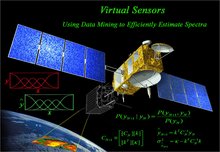
- Resources
Various instruments are used to create images of
the earth and other objects in the universe in a diverse set of wavelength bands with the aim of understanding natural phenomena. Sometimes these instruments are built in a phased approach, with additional measurement capabilities added in later phases. In other cases, technology may mature to the point that the instrument offers new measurement capabilities that were not planned in the original design of the instrument. In
still other cases, high-resolution spectral measurements may be too costly to perform on a large sample, and therefore, lower resolution spectral instruments are used to take the majority of measurements. Many applied science questions that are relevant to the earth science remote sensing community require analysis of enormous amounts of data that were generated by instruments
with disparate measurement capabilities. This paper addresses this problem using virtual sensors: a method that uses models trained on spectrally rich (high spectral resolution) data to “fill in” unmeasured spectral channels in spectrally poor (low spectral resolution) data. The models we use in this paper are multilayer perceptrons, support vector machines (SVMs) with radial basis
function kernels, and SVMs with mixture density Mercer kernels.
We demonstrate this method by using models trained on the high spectral resolution Terra Moderate Resolution Imaging Spectrometer (MODIS) instrument to estimate what the equivalent of the MODIS 1.6- m channel would be for the National Oceanic and Atmospheric Administration Advanced Very High Resolution
Radiometer (AVHRR/2) instrument. The scientific motivation for the simulation of the 1.6- m channel is to improve the ability of the AVHRR/2 sensor to detect clouds over snow and ice.
Attachments
|
3.9 MB |
|
1.7 MB |
Discussions
Popular Resources
-
Analysis of Virtual Sensors for Predicting Aircraft Fuel Consumption
A Publication, Virtual Sensors - 11 years, 3 months ago
Shared By: Ashok Srivastava
Previous research described the use of machine learning algorithms to predict aircraft fuel consumption. This technique, known as Virtual Sensors, models fuel consumption as a ...





